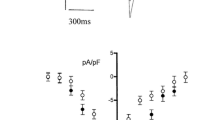Abstract
The influence of intracellular injection of angiotensin II (Ang II) on electrical properties of single right ventricular fibers from the failing heart of cardiomyopathic hamsters (TO2) was investigated in the intact ventricle of 8-month-old animals. Intracellular injection was performed using pressure pulses (40–70 psi) for short periods of time (20 ms) while recoding the action potential simultaneously from the same fiber. The results indicated that intracellular Ang II caused a hyperpolarization of 7.7 mV ± 4.3 mV (n = 39) (4 animals) (P < 0.05) followed by a small fall in membrane potential. The action potential duration was significantly increased at 50% and at 90% repolarization, and the refractoriness was significantly enhanced. The effect of intracellular Ang II on action potential duration was related to the inhibition of potassium conductance through PKC activation because Bis-1 (360 nM), a selective PKC inhibitor, abolished the effect of the peptide. Injections performed in different fibers of the same ventricle showed a variable effect of Ang II on action potential duration and generated spontaneous rhythmicity. The effect of intracellular Ang II on action potential duration and cardiac refractoriness remains for more than 1 h after interruption of the intracellular injection of the peptide.







Similar content being viewed by others
References
De Mello WC, Re RN (2009) Systemic versus local renin angiotensin systems. An overview. In: De Mello WC, Frohlich ED (eds) Renin angiotensin system and cardiovascular disease. Humana Press, NY, pp 1–5
Bader M (2002) Role of the local renin-angiotensin system in cardiac damage: a minireview focussing on transgenic animal models. J Mol Cell Cardiol 34:1455–1462
De Mello WC, Danser AHJ (2000) Angiotensin II and the heart. On the intracrine renin angiotensin system. Hypertension 35:1183–1188
Kurdi M, De Mello WC, Booz GW (2005) Working outside the system: an uptodate on unconventional behavior of the renin angiotensin system components. Intern J Biochem Cell Biol 37:1357–1367
van Kats JP, Danser AH, van Meegen JR et al (1998) Angiotensin production by the heart: a quantitative study in pigs with the use of radiolabelled angiotensin infusions. Circulation 98:73–81
De Mello WC (1998) Intracellular angiotensin II regulates the inward calcium current in cardiac myocytes. Hypertension 32:076–082
De Mello WC (1994) Is an intracellular renin angiotensin system involved in the control of cell communication in heart? J Cardiovasc Pharmacol 23:640–646
De Mello WC, Gerena Y (2008) Eplerenone inhibits the intracrine and extracellular actions of angiotensin II on the inward calcium current in the failing heart. On the presence of an intracrine renin angiotensin aldosterone system. Regul Pept 151:54–60
Re RN (2003) The implication of intracrine hormone action for physiology and medicine. Am J Physiol Heart Circ Physiol 284:H751–H757
Re RN, Cook JL (2008) The basis of an intracrine physiology. J Clin Pharmacol 48:344–350
De Mello WC (1996) Renin angiotensin system and cell communication in the failing heart. Hypertension 27:1267–1272
De Mello WC (2003) Further studies on the effect of intracellular angiotensins on heart cell communication: on the role of endogenous angiotensin II. Reg Pept 115:31–36
Li T, Sperelakis N (1983) Stimulation of slow action potentials in guinea pig papillary muscle cells by intracellular injection of cAMP, Gpp (NH) p and cholera toxin. Circ Res 52:111–117
Singh VP, Le B, Bhat VB, Baker KM, Kumar R (2007) High glucose-induced regulation of intra cellular Ang II synthesis and nuclear redistribution in cardiac myocytes. Am J Physiol Heart Circ Physiol 293:H939–H948
Rivard K, Paradis P, Nemer M, Fiset C (2008) Cardiac-specific overexpression of the human type 1 angiotensin II receptor causes delayed repolarization. Cardiovasc Res 78:53–62
Wang YH, Shi CX, Dong F, Sheng JW, Xu YF (2008) Inhibition of the rapid component of the delayed rectifier potassium current in ventricular myocytes by angiotensin II via the AT1 receptor. Brit J Pharmacol 154:429–439
De Mello WC (2001) Cardiac arrhythmias: the possible role of the renin–angiotensin system. J Mol Med 79:103–108
Wang J, Liu X, Arneja AS, Dhalla NS (1999) Alterations in protein kinase A and protein kinase C levels in heart failure due to genetic cardiomyopathy. Can J Cardiol 15:683–690
Cook JL, Mills SJ, Naquin R, Alam J, Re RN (2006) Nuclear accumulation of the AT1 receptor in a rat vascular smooth muscle cell line: effects upon signal transduction and cellular proliferation. J Mol Cell Cardiol 40:696–707
De Mello WC, Gerena Y (2009) Prolonged exposure of cardiac cells to renin plus angiotensinogen reduces intracellular renin in the failing heart. On the role of angiotensin II-AT1 complex internalization. Regul Pept 155:139–144
Jaffe IZ, Mendelsohn ME (2005) Angiotensin II and aldosterone regulate gene transcription via functional mineralocortocoid receptors in human coronary artery smooth muscle cells. Circ Res 96:643–650
Ushio-Fukai M, Zuo L, Ikeda S, Tojo T, Patrushev NA, Alexander RW (2005) cAbl tyrosine kinase mediates reactive oxygen species- and caveolin-dependent AT1 receptor signaling in vascular smooth muscle: role in vascular hypertrophy. Circ Res 97:829–836
Li XC, Zhuo JL (2008) Intracellular ANG II directly induces in vitro transcription of TGF-beta1, MCP-1, and NHE-3 mRNAs in isolated rat renal cortical nuclei via activation of nuclear AT1a receptors. Am J Physiol Cell Physiol 294:C1034–C1045
Acknowledgments
This work was in part supported by NIH grant GM 61838.
Author information
Authors and Affiliations
Corresponding author
Rights and permissions
About this article
Cite this article
De Mello, W.C. Intracrine action of angiotensin II in the intact ventricle of the failing heart: angiotensin II changes cardiac excitability from within. Mol Cell Biochem 358, 309–315 (2011). https://doi.org/10.1007/s11010-011-0981-4
Received:
Accepted:
Published:
Issue Date:
DOI: https://doi.org/10.1007/s11010-011-0981-4




